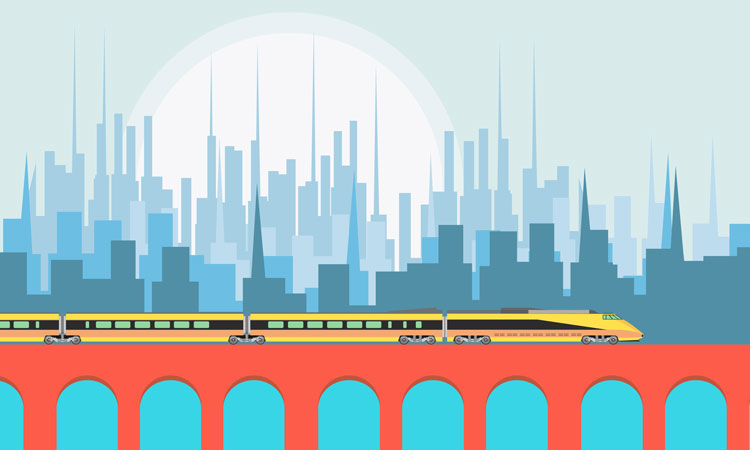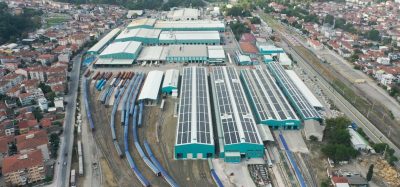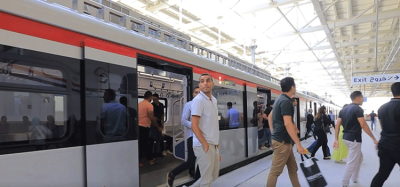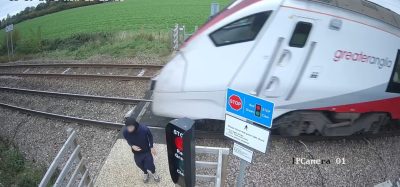Would a high-speed rail service between Chicago and NYC be popular?
Posted: 1 May 2020 | Mike Lehman | 11 comments
Mike Lehman, a campaigner to develop a sustainable electric high-speed train line between downtown Chicago and downtown New York City – connecting over 15 major U.S. cities – discusses the benefits of this proposed line, and why he thinks the U.S. must embrace and support its development.


High-speed rail advocacy groups, state Departments of Transportation, corporations and other organisations are urging the U.S. Department of Transportation (USDOT) and the Federal Railroad Administration (FRA) to acquire the land and build the infrastructure necessary for the operation of a true Asian-European-style sustainable electric high-speed ‘bullet’ train – dubbed the ‘NCBT’ – from downtown Chicago to downtown New York City, ultimately connecting over 15 major U.S. cities and eventually connecting 120 city pair combinations.
The NCBT proposal offers an alternative mode of transportation that is more environmentally friendly than air travel to residents in the high-traffic and air polluted areas of Illinois, Indiana, Ohio, Michigan, New York-New Jersey and Pennsylvania, among others.
Research suggests that this proposed alignment will have the most significant and positive impact on U.S. transportation habits, and is an alignment that has been much desired throughout U.S. history. It is also the natural progression of the popular Northeast HSR Corridor (NEC) from Boston to Washington DC that is already in use.
Calls have been made to make this alignment – approximately 700 miles from the Chicago/Great Lakes Corridor to the Philadelphia/Northeast Corridor – a priority above and beyond all other high-speed lines proposed or under construction in the U.S. because of its potential use by over half of the country’s population. Furthermore, this new high-speed route is part and parcel of the many efforts going forward for the U.S. virtue of finally reducing itself of its intense generational and very expensive oil addiction.
Proposal for the high-speed rail line between Chicago and NYC
The old paradigm of passenger trains only using rail freight infrastructure, or incrementally higher speed rail projects of 500 miles or less only, and diesel locomotive power is over.
The public want 200mph high-speed train systems connecting major cities using sustainable, responsible technologies – such as electric – which has been used on other high-speed systems worldwide for decades now.
The NCBT proposal offers an alternative mode of transportation that is more environmentally friendly than air travel to residents in the high-traffic and air polluted areas of Illinois, Indiana, Ohio, Michigan, New York-New Jersey and Pennsylvania, among others. There are currently thousands of daily commercial intercity flights between these states and cities, burning billions of gallons of jet fuel every year – unsurprisingly making it the most air polluted corridor in the U.S.
Fees generated from passenger flights – as well as oil, gasoline and jet fuel – need to be some of the dedicated sources of funding for NCBT infrastructure in order to alleviate the many issues related to oil-dependent transportation.
Five main reasons for sustainable electric high-speed trains
There are five main reasons why sustainable electric high-speed travel is beneficial:
- It is a non-oil dependent mode of transport
- It offers great reductions in air pollutions/carcinogens around airports and cities
- Rail travel is the safest mode of transport in the world
- It offers major growth in downtowns near high-speed train stations
- It is an important alternative to personal vehicle travel and air travel for intercity journeys.
California, the Northeast and other regions of the world – including China and Russia – already have high-speed rail lines under construction or in the planning stages. U.S. states that have financially supported Amtrak/passenger rail should be rewarded for that support and be able to participate in new high-speed train initiatives. For comparison, the logistics/demographics of the NCBT route connects 100 million more people than California’s existing high-speed rail plans in a similar length footprint.
A superior alternative to gas-guzzling air travel
High-speed trains and the lines on which they operate offer a superior substitute for gas-guzzling and polluting airplanes.
High-speed trains and the lines on which they operate offer a superior substitute for gas-guzzling and polluting airplanes, and they are a key green part of the necessary diversification of transportation energy (such as electric/hybrid cars, alternate transport fuels, etc.) needed to reduce oil dependency. Presently, 70 per cent of oil use is for transportation and liquid fuels, such as gasoline and jet fuel.
As for energy overall; coal is for electricity, natural gas is for heating, but oil’s primary use is for transportation. Wind, solar, hydro/water and nuclear powers are also for electricity – the U.S. has plenty of varied electric energy capacity to run trains and high-speed rail infrastructure for a long, long time.
Justifications for the new high-speed rail line between Chicago and NYC:
1. Many states would benefit
The NCBT proposal is for an exciting, strategic and practical high-speed rail line that is powered by electricity and which would use both ‘dedicated’ and existing infrastructure.
The NCBT proposal is for an exciting, strategic and practical high-speed rail line that is powered by electricity and which would use both ‘dedicated’ and existing infrastructure. The energy, economic, security and health rationales for this new, dedicated mode would mostly be for servicing the states of Illinois through to New York/New Jersey, connecting the cities of Chicago, Cleveland, Pittsburgh, Philadelphia and New York. Detroit and Cincinnati/Ohio can be individual high-speed rail line origin-destination points. The total linked U.S. high-speed rail systems state populations are over 150 million, representing approximately half of the U.S. population.
2. Cost-effective
The Great Lakes/NCBT corridor high-speed line could carry in excess of 100 million passengers a year, drawing travellers from air and bus, but, mostly, automobile modes, in addition to acquiring new high-speed rail travellers. Over its very long functional lifetime, the properties of the system and large initial capital investments would prove to be very productive and efficient. In contrast, relative past operations costs and subsidies of the aforementioned cities’ air transport, interstates roads and highways were, and are, recurring and far more expensive than what the cost operations of the new route would be.
The Great Lakes/NCBT corridor high-speed line could carry in excess of 100 million passengers a year, drawing travellers from air and bus, but, mostly, automobile modes, in addition to acquiring new high-speed rail travellers.
The estimated 100 million passengers a year is equivalent to approximately half of commercial aviation enplanements in the Great Lakes/Northeast corridor cities of the over 700 million annual domestic enplanements in the U.S. In Japan (approximate population 126 million), high-speed rail usage is over 130 million trips a year; in France (approximate population 66 million), high-speed rail usage is over 50 million trips a year.
The NCBT proposal will be unpopular with air and road transport related industries/lobbies (nine out of the 10 largest companies worldwide either produce automobile or petroleum products). However, it should not be, since additional passenger railroad capacity also alleviates some of their own modes’ problems. Hopefully progress and logic will prevail, and this new high-speed rail proposition can develop and thrive, despite other interests.
3. Economic reasons
There would be new job creation generated by construction of the NCBT route and the continual operation and maintenance of the route. Ridership levels should reach and exceed the levels of the similar French TGV high-speed train, which has over 50 million annual trips and revenues of approximately $5 billion a year.
With potential revenues on the NCBT route of $5 billion or more a year, the large investment in the line’s infrastructure and trainsets would be paid for, realistically, within several years’ time, similar to the French TGV experience.
There would be new job creation generated by construction of the NCBT route and the continual operation and maintenance of the route.
This new high-speed rail route would augment and strengthen Amtrak’s abilities and potential elsewhere on complementary routes and that of the Acela/Northeast corridor (NEC), which is Amtrak’s most profitable and popular route.
High-speed rail in the proposed region would enhance cities’ CBDs and integrated rail development. Proposed Phase 1 connected cities – Chicago, Cleveland, Pittsburg and Philadelphia – are expanding their own internal transit rail systems, proving that these cities are not entirely reliant on cars.
4. Security reasons
Acts of terrorism occur more often with air travel (hijackings, bombings, sabotage, poisonings etc.) These attacks are significantly rarer on rail transport networks, and the proposed NCBT would not call for the same extreme level of security expense which airports and airlines require.
In the advent of an airspace shutdown or bad weather, the NCBT corridor would serve as another travel alternative to air and road in the northeast U.S. and Great Lakes region.
5. Health, safety and environmental reasons
In the U.S., approximately 50,000 people die and tens of thousands more are permanently disabled every year from road-related accidents. So, of course, less driving would result in reduced death rates across the U.S. Hundreds more people are killed and severely injured yearly in intercity plane crashes, too. In France and Japan, high-speed trains have not had a passenger fatality in over 90 years combined. Thousands of lives and billions of dollars can be saved by using high-speed trains in lieu of personal vehicles and aircraft.
Thousands of lives and billions of dollars can be saved by using high-speed trains in lieu of personal vehicles and aircraft.
It is anticipated that most high-speed rail infrastructure could be built adjacent to existing highways and railroad lines for environmental considerations and land use purposes (aircraft and road vehicles generate lots of noise and are big air and land polluters).
Over one third of Americans don’t like to fly, leaving long, congesting, costly and hazardous car and bus travel or complex Amtrak timetables as their only alternatives.
Airport traffic creates more pollutions/carcinogens/congestions around large population centres. There is a total of eight potential congestion-adding car trips to and from airports to pick-up and drop-off a flyer at both destinations per roundtrip. The combination of traveling by rail, then walking, is much healthier and more beneficial compared to the customary airplane/car combination.
I believe a fresh, new approach to high-speed rail travel is required in the U.S. and the positive benefits of a Chicago-NYC route are too great to be ignored.
Related topics
Electric/Hybrid Rolling Stock, High-Speed Rail, Infrastructure Developments, Operational Performance, Passenger Experience/Satisfaction, Regulation & Legislation, Rolling Stock Orders/Developments, Route Development, Sustainability/Decarbonisation, Track Construction
Related organisations
Federal Railroad Administration (FRA), U.S. Department of Transportation (USDOT)








I love it!
The Senate bipartisan Infrastructure Bill
is working thru Congress.
Nice easy curves out of stations. Actually, HSR uses an existing rail to start out then transitioning out of town. This is what the European operators do so you are building less than 75%of the row. Called the Integrated system. Check out HSRail.org
for details. Joe
Ray, Come on, man. You understand Transportation economics, don’t you? 2 hours the minute you step off and on a plane… And how about the eight hours going to and from airports on both ends and another 8 hours going through security luggage and long airport corridors on either end…
I wasn’t going to answer this cuz that’s an old excuse. It doesn’t make sense.
On my Facebook page, I address this issue of trains vs. Planes and times… regards
Explain to me how high speed rail is going to save me any time? I can fly from Chicago to NYC in about 2 hrs of air time. Unless the train is going 400-500 mph how is going to get me to NYC any faster since I assume the people in Cleveland, Pittsburgh, and Philadelphia also want the train to stop in their cities too.
One trillion dollars?!. What are you out of your mind? The highest I’ve heard is 50 million per mile, and we really only need 600 miles from Chicago to Harrisburg, Pennsylvania, and we will share/rent infrastructure with the railroad lines along the way and stations along the way. You are highly exaggerating or lying about your intentions here.
Also Farmland is Very cheap in Indiana and Ohio. I know my relatives are farmers $5,000 per acre.
And one last thing sustainable electric green bullet trains can use wind solar hydro other power …dirty stinky noisy airplanes can only ever burn oil.
Will this happen in the United States of America? Not likely, because we are no longer able to plan for and build major infrastructure projects. Besides, there’s no will to finance huge expenditures like this proposal. Add to that, the airline and highway interests will block it, because it threatens their dominance of the transportation industry, and they’re not about to allow that to happen.
If we’re going to see anything new happen in the field of transportation, it will be Elon Musk coming forward with his proposal to build his Hyperloop between Chicago and New York. Why? Because what he is offering is EXCITING and NEW and INNOVATIVE! (Trains are so “old-school”!)
Bullet trains are not old school. Asia and Europe have built thousands of miles of it recently.
I am counting on the younger generations to be more green Progressive informed… And get back to infrastructures and meaningful projects.
The old American cultures of oil Wars Wall Street bailouts cars congestions needs to die off… and Dirty carcinogenic noisy airplanes has run its course too.
That’s what’s old school.
Thanks
Being extremely generous, If you had 1 trillion to start this high speed rail project from Chicago to New York you could possibly:
(1) Purchase the real estate needed from Chicago to New York.
(2) Allot the money needed to design the plan which consists of considerations and endless change orders related to rerouting; water/sewer, electrical lines, fiber optics, houses, cutting back easements, etc..
(3) Paying the construction costs to begin excavation of 790 miles (We’re giving you a *straight line which you know that is not possible). This does not include ballast, laying track, inspection, concrete ties, CWR, or surfacing.
*Last time we checked, high speed rail does not have to tight of curves so you wont be taking a nice easy tangent line to a city and making the curve a mile out around a city. You’ll need to start diverging maybe 10 miles earlier and that means hello farmer fields! That means major bucks paid out to farmers to use their land. If they want to let you use their land at all. Why would they? Oh by the way, you cannot have public crossings with trains that travel in access of 125 mph. So now you have to build either bridges or underpasses. Hello drainage studies and major pile driving and steel h-pile and sheeting needed to build those thousands of bridges. That’s cut into that trillion quite a bit.
(4) Security! You will have to pay to have security protecting infrastructure that is being built, construction equipment sprayed all along the corridor. We know environmental activists are harmless as doves but you’ll need security to protect your corridor and that overhead power supply from those jackwagons.
(5) Roadway Worker In Charge (RWIC) costs. You have to pay for flaggers which is steep! How does 60k a month sound for just two flaggers on a 3 mile stretch? That’s what one class one rr is charging the Govt to provide flagging services. You will be needing protection for more than three miles along that line since you will be having to deal with multiple railroads.
Dig deep! We haven’t even laid the track yet but you’ve just used up your trillion dollars. You haven’t even paid out the contracts to build the the locomotive consist, cars, and inspection vehicles needed yet. You do not even have the engineers and conductors yet- let alone paid them to start. You’ll have to contract out all repair work.
Expect this project to last 10 years at minimum and animal rights and environmental activists fighting you every step of the way. That means you’ll be paying court costs and be involved in perpetual litigation, safety mitigation, and having to speak at a number of city forums.
Oh by the way, there is this thing called Covid-19. Have you heard of it? Yeah it’s been lovely for encouraging travel. People are not going to travel as much anymore so the ‘will’ for this may not even exist. In all reality, if this was going to be done, it should have been started in the 1950’s. As sad as it is to say, America is not capable of appropriating the funds, unifying the public support, and financially sustaining such an undertaking. As far as the potential project timeline- this project is going to have to survive potentially three administrations.
Well China built 20,000 miles in the last 10 years of bullet train right of way and Europe and Japan have another 10,000 miles. They didn’t have a problem. Yeah, it’s expensive. It’s jobs. It’s green. It’s safe. Its infrastructure… And it will be very popular just like all the other Global bullet train lines…
BTW Aviation is a huge polluter. Airplanes can burn 10 20 50000 gallons of oil per flight.
Put simply and directly, the United States long ago lost the will and the resolve to take on and successfully complete large infrastructure projects, as it was able to a century ago, in the early 1930s, when the giant Hoover Dam was built, or even in the late 1950s/early 1960s, when then-President Eisenhower proposed and built our Interstate Highway System.
By contrast, today’s Americans, 1) can’t agree on anything – they’re too partisan and polarized. Large public projects are “off the table” with the Republicans, who have no interest in anything “public.” 2)NIMBY-ism, or “Not In My Back Yard,” you won’t!”, would tie up a Chicago-New York high-speed train for decades on end in the courts (all one has to do is look at what is happening in Texas with the Houston-Dallas Texas Central high-speed train, which is relatively easy to build due to the wide-open terrain, and would be entirely paid for by a Japanese Consortium. EVEN SO, the land-owners along that route are fighting tooth-and-nail to stop it. Now, that the coronavirus pandemic has thrown a monkey wrench into the very idea of traveling on ANY public conveyance, be it a lowly bus, an Amtrak or high-speed train, or an airplane, the Texas Central idea will never leave the engineers’ and designers’ drawing boards.
So, we are totally wasting our time with fruitless proposals like this one! All America can do is TALK about big things – but it cannot ACT on them. Those days ended decades ago. All we Americans can do now is think and act SMALL.